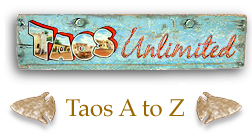|
|||
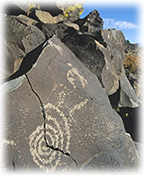 Paseo PaseoDefinition: “a plaza or walkway for strolling; a leisurely walk or stroll, especially one taken in the evening.” Many major street names in Northern New Mexican towns include the word paseo. (~Jean) Petroglyph Definition: “a rock carving, especially a prehistoric one.” Petroglyphs and pictographs are the oldest and most widespread forms of creative and cultural expression in the Native American Southwest. Petroglyphs are carved into the rock, while pictographs are painted designs. These visual inscriptions can be found in abundance throughout Northern New Mexico on mesas, rock walls, caves, cliff dwellings, etc. Petroglyphs, which are more common than pictographs, are found on the dark, exposed surfaces of rock such as sandstone and basalt. These surfaces serve as the base color for abstract and realistic human, anthropomorphic supernatural, animal and plant figures, as well as designs such as spirals, circles, and stars. The three major Southwestern Indian groups who created rock art were: the Hohokam of Southern Arizona; the Mogollon of Southern Arizona, New Mexico and West Texas; and the Anasazi (now known as the Pueblo Indians) of Southern Utah, Northern New Mexico and Arizona. They existed from approximately AD 1 to 1500. The Navajos and Apaches began their rock-art traditions at a later time. It is ceremonial in nature and is located in Northwestern New Mexico, Northern Arizona, and Southern Utah. (~Jean) 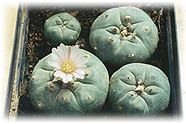 Peyote PeyoteA wooly Mexican spineless cactus, which can be found in central Mexico and throughout the American Southwest. The above ground plant is made up of a circle of "buttons," which have a high concentration of mescaline. Because of its hallucinogenic properties, peyote has played a major sacramental role among the Huichol and other Indians of Mexico for approximately 2,000 years, while its use has spread to the North American tribes in the last hundred years. During the 1960s and 1970s, numerous books written by Carlos Casteneda expanded the use of peyote to American youth. (~Aimee) Picante Sauce Definition (picante): “spicy; in Spanish, literally pricking, biting, or stinging.” Picante sauce is a term coined by condiment maker David Pace for his own version of salsa. Picante sauce is usually a little more pureed than bottled salsa, but is chunkier than fresh red salsa. (~Jean) Pictograph 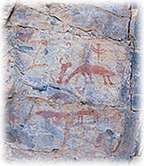 Definition: “a painted pictorial symbol for a word or phrase; pictographs were used as the earliest known form of writing.” Pictographs and petroglyphs are the oldest and most widespread forms of creative and cultural expression in the Native American Southwest. Pictographs are painted designs, while petroglyphs are carved into the rock. In prehistoric Utah, Arizona, New Mexico, Texas and Colorado, hunter-gatherer Indians began to decorate canyon walls, rock shelters, and boulders with rock art. These visual inscriptions can be found in abundance throughout Northern New Mexico on mesas, rock walls, caves, cliff dwellings, etc. Pictographs are usually found on light-colored, protected surfaces. Stylized animals and humans and geometric objects are common subjects. Pictograph pigments were made from soot or powdered local minerals. Brushes were probably made from the tips of yucca leaves. The three major Southwestern Indian groups who created rock art were: the Hohokam of Southern Arizona; the Mogollon of Southern Arizona, New Mexico and West Texas; and the Anasazi (now known as the Pueblo Indians) of Southern Utah, Northern New Mexico and Arizona. They existed from approximately AD 1 to 1500. The Navajos and Apaches began their rock-art traditions at a later time. It is ceremonial in nature and is located in Northwestern New Mexico, Northern Arizona, and Southern Utah. (~Jean) Definition: “a painted pictorial symbol for a word or phrase; pictographs were used as the earliest known form of writing.” Pictographs and petroglyphs are the oldest and most widespread forms of creative and cultural expression in the Native American Southwest. Pictographs are painted designs, while petroglyphs are carved into the rock. In prehistoric Utah, Arizona, New Mexico, Texas and Colorado, hunter-gatherer Indians began to decorate canyon walls, rock shelters, and boulders with rock art. These visual inscriptions can be found in abundance throughout Northern New Mexico on mesas, rock walls, caves, cliff dwellings, etc. Pictographs are usually found on light-colored, protected surfaces. Stylized animals and humans and geometric objects are common subjects. Pictograph pigments were made from soot or powdered local minerals. Brushes were probably made from the tips of yucca leaves. The three major Southwestern Indian groups who created rock art were: the Hohokam of Southern Arizona; the Mogollon of Southern Arizona, New Mexico and West Texas; and the Anasazi (now known as the Pueblo Indians) of Southern Utah, Northern New Mexico and Arizona. They existed from approximately AD 1 to 1500. The Navajos and Apaches began their rock-art traditions at a later time. It is ceremonial in nature and is located in Northwestern New Mexico, Northern Arizona, and Southern Utah. (~Jean)Piñon 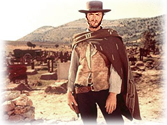 A slow growing member of the pine family which yields an edible nut. Piñon (or pine) nuts were a staple among Indians of the Southwest, and are still prized today. The slow burning wood of the piñon is highly regarded for its scent, which is unmistakable in the air of Taos and Santa Fe as autumn turns to winter. (~Aimee) A slow growing member of the pine family which yields an edible nut. Piñon (or pine) nuts were a staple among Indians of the Southwest, and are still prized today. The slow burning wood of the piñon is highly regarded for its scent, which is unmistakable in the air of Taos and Santa Fe as autumn turns to winter. (~Aimee)Poncho An outer garment of a type originally worn in South America, Mexico, and by Indians of the Southwest. It is made of a thick piece of woolen cloth with a slit in the middle for the head. The poncho became very popular among 1960s hippies, and can be found in use just about anywhere in the U.S. today. (~Aimee) Prairie Schooner (or Covered Wagon) 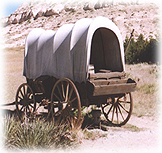 A large wagon ( in the style of a Conestoga wagon, but much lighter) fitted with thin, supple hoops made of wood, and covered with a canvas "bonnet" to protect settlers and their belongings from wind and dust. These were almost universally used in the migration across the western plains. These lighter wagons could be drawn by four horses or oxen rather than the six it took to pull the heavier Conestoga. In crossing the Great Plains, groups of prairie schooners customarily traveled together for protection. Traveling in this fashion was known as a "wagon train." (~Aimee) A large wagon ( in the style of a Conestoga wagon, but much lighter) fitted with thin, supple hoops made of wood, and covered with a canvas "bonnet" to protect settlers and their belongings from wind and dust. These were almost universally used in the migration across the western plains. These lighter wagons could be drawn by four horses or oxen rather than the six it took to pull the heavier Conestoga. In crossing the Great Plains, groups of prairie schooners customarily traveled together for protection. Traveling in this fashion was known as a "wagon train." (~Aimee)Pictured top to bottom: 1} Petroglyph in a rock outside Santa Fe, New Mexico; 2} Peyote plants; 3} Pictograph found in Northern New Mexico; 4} Mexican style poncho on actor, Clint Eastwood; 5} Prairie Schooner in the desert |
|||
Home | Food | Lodging | Merchants | Services | Real Estate | Art & Galleries | Entertainment | Recreation Ski Areas | Mind-Body-Spirit | Taos Information | Local Color | Taos Pueblo | High Road to Taos | Taos Plaza | Ranchos de Taos Scenic Beauty | Day Trips | Chili | Special Events | Taos History | Multicultures | Museums | The Enchanted Circle The Wild West | Taos Art Colony | Plants & Wildlife | Counterculture | Turquoise | Architecture | Features | About Us | Get Listed! Taos Unlimited Trading Post | Photo of the Week | Link of the Month | Taos Webcams | Taos Weather | Testimonials | Guestbook Taos A to Z | Movie Locations | Sitemap | Taos Unlimited Blog | Aimee & Jean's Story Blog | Contact Us | Santa Fe Unlimited |
|||

